Chapter 7 Statics And Dynamics Of Fluid Fluid
A substance which has no definite shape and has the ability to flow from one place to another is called a fluid. In this sense, all liquids and gases are fluids. The only difference is that a liquid can not be compressed but a gas can be compressed.
Chapter 7 Statics And Dynamics Of Fluid Concept Of Pressure
Each and every substance has weight and anything that has weight can exert pressure. A solid exerts pressure due to its weight only on the surface on which it is placed. Let us try to understand the concept of pressure through the following examples.
“WBBSE Class 6 General Science Chapter 7 statics and dynamics of fluid notes”
Example-1:
Take one pointed nail, one blunt nail and a wooden block. Try to drive the nails separately into the wooden block by hammering their heads with equal force. You see that the pointed nail enters easily into the block, but the blunt nail does not.
Example-2:
Take a ballpoint pen. It has a pointed tip and a blunt back. Try to pick a paper separately with the two sides of the pen by applying equal force. Pricking of paper is easily done by the pointed tip than the blunt back. Piercing ability is more for the pointed tip than the blunt back.
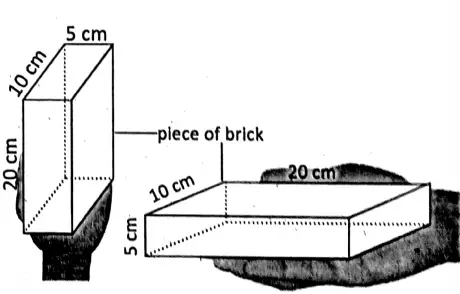
Example-3:
Keep a brick on your palm with its longest side vertical, as shown in the given. You feel maximum pressure on your palm at this position of the brick. Now, keep the same brick on your palm with its shortest side vertical, as shown in the given. You feel the minimum pressure.
Read and Learn More WBBSE Notes For Class 6 General Science and Environment
Inference:
The effect of applied force increases as the area upon which it acts decreases and vice versa. Therefore, it can be said that the effect of a force depends on the area upon which it acts. This inference gives rise to the concept of pressure.’
| Class 6 History | Class 6 Social Science |
| Class 6 Geography | Class 6 Science |
| Class 6 Maths | Class 6 Science MCQs |
| Class 6 General Science | Class 6 Maths Solutions |
| Class 6 Geography | Class 6 Hindi |
“WBBSE notes for Class 6 Science statics and dynamics of fluid”
Pressure is defined as the force acting on the unit area to the surface of a substance. If ‘F’ be the force and ‘a’ be the area then the pressure would be
p= F/a or, F = p x a i.e. force = pressure x Area
In example-1, the area of the pointed edge of the nail is too small. Hammering its head by a force, the pressure at the pointed edge becomes high enough and the nail can penetrate the wooden block easily.
The ends of nails, screws, knives, cutters, needles, pins, etc. are made sharp to reduce the effective surface area on which the force acts.
Unit of pressure:
SI unit of pressure is newton per square metre (abbreviated as N.m-2). It is also called Pascal (symbol Pa) in the honour of physicist Pascal. Its bigger unit is kilo Pascal or kPa.
1 kilo Pascal = 1000 Pascal
Chapter 7 Statics And Dynamics Of Fluid Effect Of Pressure
A liquid also exerts pressure due to its weight at the bottom of the container as well as on its walls. This happens due to the tendency of the flow of liquid.
Hands-on Activity
See the shown alongside.
A hole is made at any point on the wall of a water bottle. Hold the bottle as shown in. Water spurts out through the hole normally with the wall. If you try to block the flow of water by a finger, you feel the water pressure.
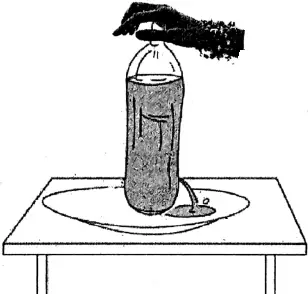
Note: The spurting out of water depends upon its pressure but not on the force.
Do you know that the pressure at a point inside a liquid increases with the increase in its depth from its free surface
Hands on Activity
As shown in the left side, on the three holes are made on the wall of a pot at different heights. Cover the holes with wax. Then fill the pot with water. Hold the pot as shown in.
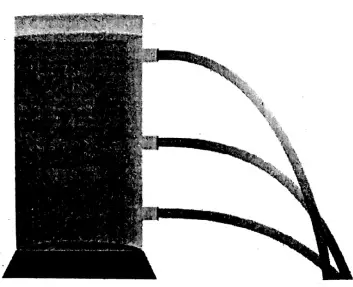
Now with the help of a pin, remove the wax covers as quickly as possible so that all three holes are made open almost at the same time.
What will you see?
You will see that the stream of water from the lowest hole gushes out with maximum speed and falls the farthest, and the stream from the uppermost hole travels the least distance.
Reason:
The depth of the lowest hole from the free surface of the water is maximum and it creates more pressure so that water reaches a longer distance on the ground. As the depth increases, the pressure of water also increases.
Conclusion: The greater the depth, the greater is the pressure.
Hands on Activity
As shown in connecting a narrow cylinder with a widespread big cylinder through a pipe. Connect a stopcock with the pipe. Keeping the stopcock closed, fill the narrow cylinder with water. Then pour water into the big cylinder.
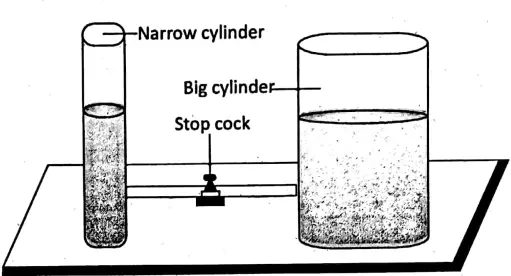
Open the stopcock and see what happens. Water flows from the narrow cylinder to the big cylinder although the big one contains about three times the water of the narrow one.
Why?
The height of water in the narrow cylinder is greater than that in the big cylinder. Greater height means greater depth and so, pressure is also greater. So that the flow of water depends on its height-not on its quantity.
“Class 6 WBBSE General Science Chapter 7 fluid mechanics explained”
Conclusion: Water (or any liquid or gas) flows from a place of higher pressure to a place of lower pressure.
Chapter 7 Statics And Dynamics Of Fluid Air Pressure
Already we’ve learnt that each and every substance has weight and anything that has weight can exert pressure. Air is light no doubt, but it is not weightless. So, air can exert pressure.
The air above the earth’s surface is considered to be divided into several air columns. Each and every air column has to bear the weights of the columns above.
Hence, the weight of the air column exerts a thrust (a force acting normally) on the earth’s surface and this gives rise to atmospheric pressure.
Air exerts pressure from all directions:
Two hollow hemispheres made of brass are taken. A ring is fitted at the end of one hemisphere, and a stopcock is fitted with the other hemisphere.
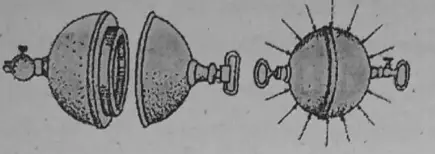
The rim of each of hemisphere is so designed that they can be fitted to each other to form a hollow sphere. The hemispheres are fitted exactly to each other by vaseline. The stopcock is opened and an air suction pump is attached to it.
Remove the air from within the sphere by the pump. At this position, it is found that the hemispheres cannot be detached. However, if the air is entered in the sphere by opening the stopcock-then the hemispheres can be pulled apart easily.
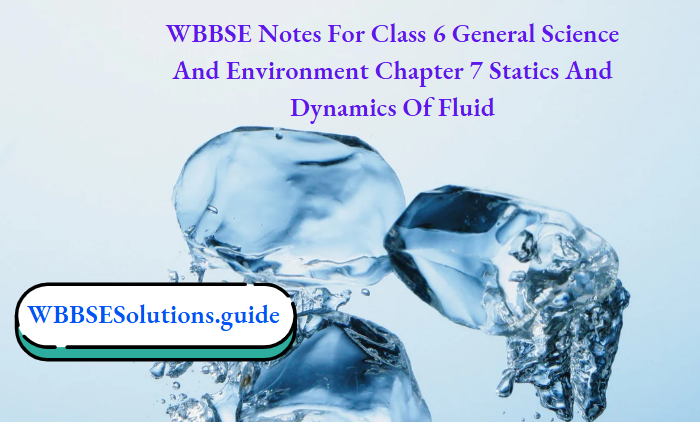
Reason:
Initially, the hemispheres can be separated easily as the air pressure inside and outside the sphere were the same.
But when the inner side of the sphere becomes completely vacuum, then air from outside exerts pressure from all directions over the sphere and the hemispheres can not be detached.
We have learnt that “Force = Pressure x Area”.
“Step-by-step notes on statics and dynamics of fluid Class 6 WBBSE”
This implies that the action of force due to pressure increases with the increase of surface area upon which the force acts. For example, the pressure of air on a big piece of paper is larger than that on a small piece of paper.
Chapter 7 Statics And Dynamics Of Fluid Concept Of Bernoullis Principle
Bernoulli’s principle states that a fluid (liquid or gas) in motion exerts less pressure at a place where the speed is high.
Hands-On Activity
Folding cardboard in its two sides makes a bridge. Keep the bridge on a table. Then, blow your breath strongly under the bridge as shown in. The bridge is not seen to fly away from the table.
Why?
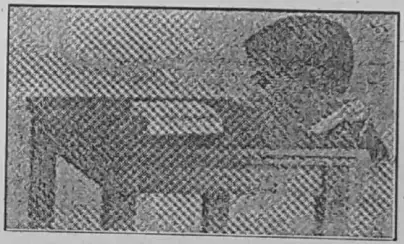
“WBBSE Class 6 General Science Chapter 7 important questions and answers”
According to Bernoulli’s principle, the air with very high speed under the bridge produces a very low pressure there. At that time, the air above the bridge exerts high pressure over it by which the bridge lowers down but is not displaced.
Hands-On Activity
Take a page and blow your breath strongly over it, as shown in shown at the top of the next page. Then stop blowing, and again blow. You see when you blow strongly the page remains flat. But when you stop blowing, the page falls.
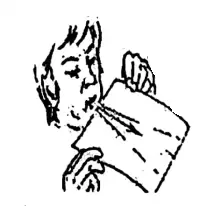
In this case, also the moving air above the page creates a low-pressure region, while the pressure of air below the page becomes greater. This upward pressure helps to keep the page flat.
Hands-On Activity
Take two flat pages and hold them in front of your mouth keeping a little gap between them, as shown in the shown left. Blow strongly through the passage between the pages. You see the pages stick together as long as you blow.
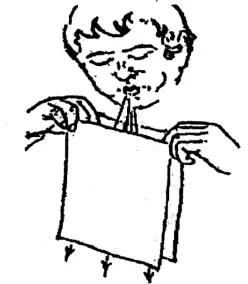
Here also through this passage the pressure of the air becomes reduced, while the pressure of the air outside the pages becomes greater. This greater pressure pushes the pages to come closer.
WBBSE Notes For Class 6 General Science and Environment
-
- Chapter 1 Interdependence of Organisms and the Environment
- Chapter 2 Phenomena Around Us
- Chapter 3 Element, Compound and Mixture
- Chapter 4 Rocks and Minerals
- Chapter 5 Measurement
- Chapter 6 Primary Concept of Force and Energy
- Chapter 7 Statics and Dynamics of Fluid
- Chapter 8 The Human BodyChapter 9 Common Machines
- Chapter 10 Biodiversity and its Classification
- Chapter 11 Habits and Habitats of Some Important Animals
- Chapter 12 Waste Products
